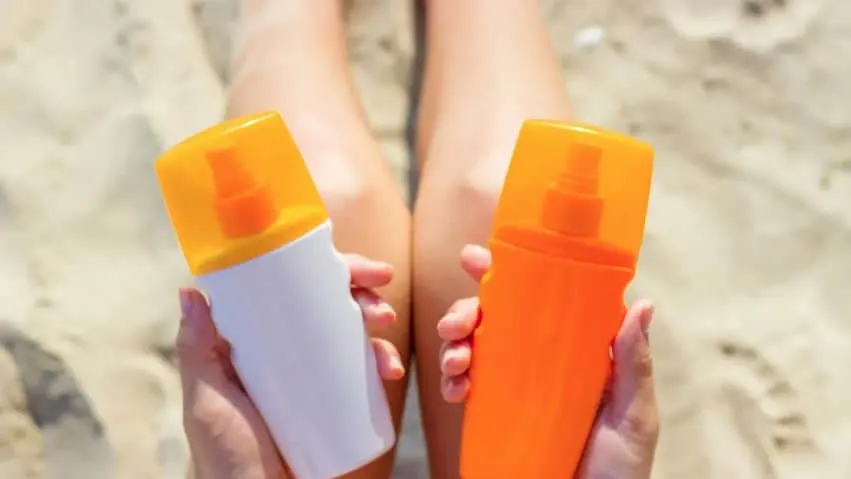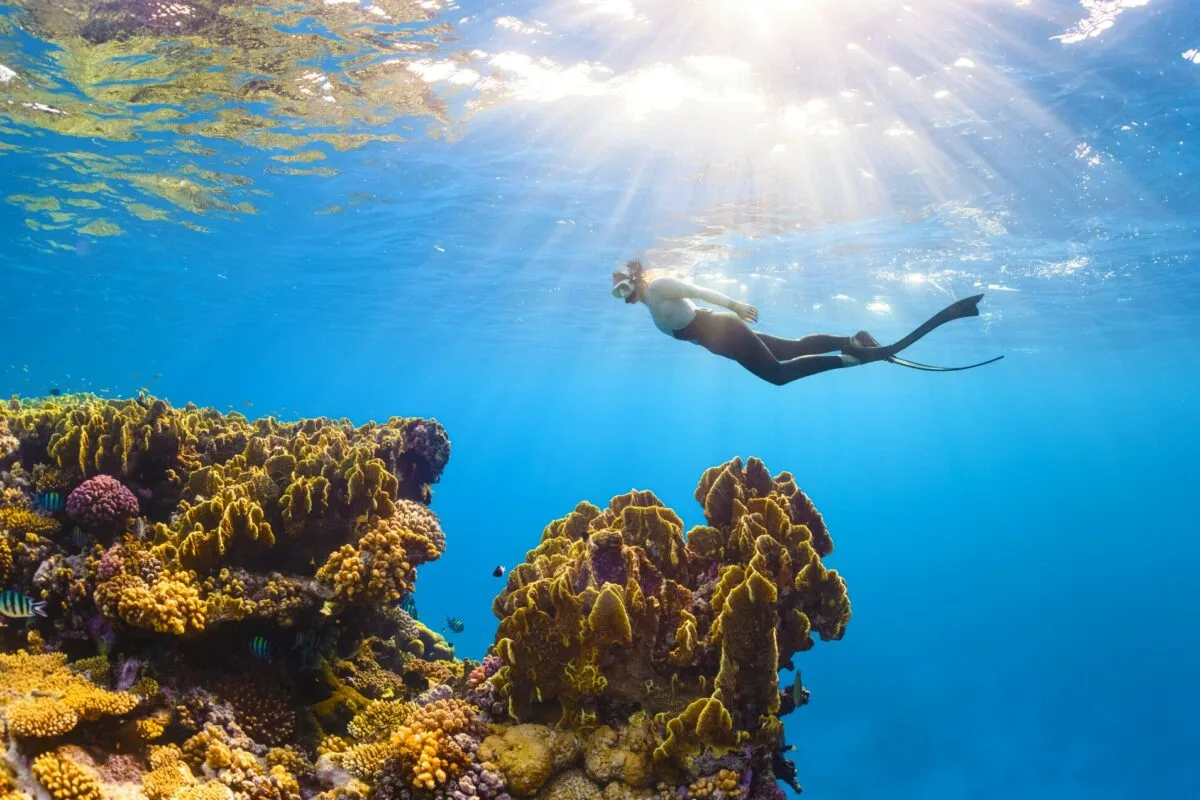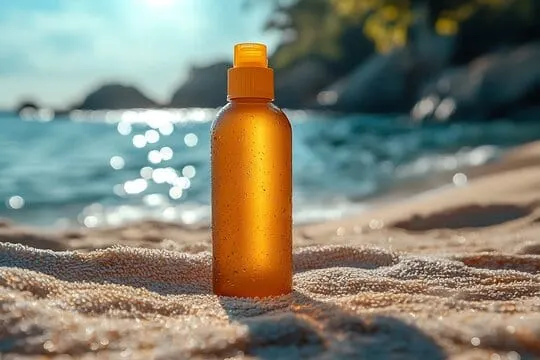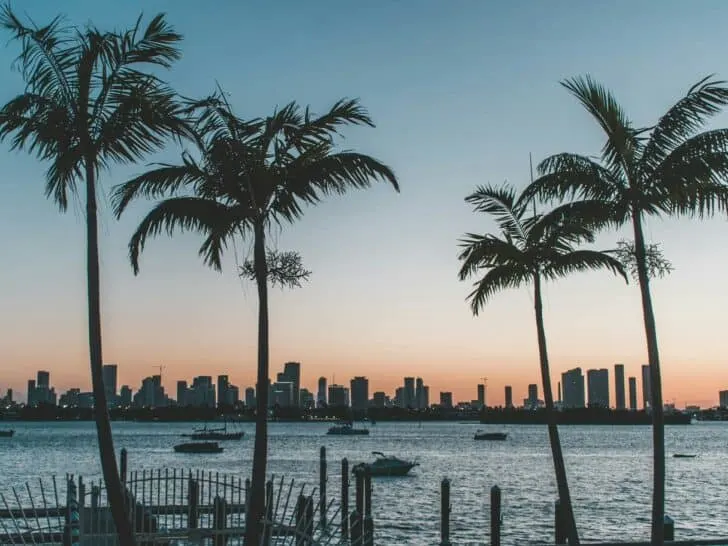
Ecotourism may be a new trend, but it mustn’t be a passing one. When planning an ocean destination vacation, few people consider it their responsibility to maintain that beauty for future generations. With one tiny change to the packing list, beach-goers can help protect our oceans and reduce the loss of coral reefs.
The secret isn’t taking a reusable water bottle instead of a disposable one. It isn’t choosing public transportation to reduce carbon emissions or renting an EV over a combustion engine. It’s even simpler than all that!
When ocean-goers pack reef-safe sunscreen instead of conventional petrochemical options, they protect the coral reefs and potentially human health. No matter what water you swim or bathe in, reef-safe sunscreen makes a difference–even thousands of miles from an ocean.
What Is Reef-Safe Sunscreen?
The crucial difference between sunscreens that qualify as reef-safe and those that do not are the active ingredients. In 2015, Haereticus Labs identified two common ingredients and conventional sunscreens as culprits in coral reef bleaching, i.e., death: oxybenzone and octinoxate. Before that point, finding chemical sunscreen without oxybenzone and octinoxate was nearly impossible. In fact, oxybenzone was so pervasive researchers detected it in over 97% of human urine samples.
For years, sunscreens had been labeled “reef safe” without any official scientific guidelines for the definition of this term.
The quickest way to find reef-safe sunscreen is to look at the active ingredients. Zinc oxide should be the only item listed. As a nonreactive mineral, zinc oxide is thought to be incredibly reef-safe. It is also fully broad spectrum, protecting human skin from UVA as well as UVB rays at the most equal rate of any compound available.
Some decent quality options also include titanium dioxide, but zinc is more effective as sunburn protection.
Why Choose Reef-Safe Sunscreen?

Coral reefs don’t perish like other marine animals but slowly lose their vibrant colors and turn white, a process called coral reef bleaching. This bleaching occurs when corals expel the symbiotic algae living within their tissues. Various factors can stress the corals, and they kick out their resident algae. If conditions improve, corals can sometimes recover and regain their algae, but prolonged bleaching can lead to coral death and the degradation of the entire reef ecosystem.
The study from Haereticus Labs showed unequivocally that oxybenzone and octinoxate have a direct causal effect on coral reef bleaching. A brief in the Journal of Science Policy & Governance in April 2024 states that “between 6,000 and 14,000 tons of sunscreen, many of which contain between 1-10% oxybenzone, are released into coral reef areas each year. This places at least 10% of the global reefs and 40% of coastal coral reefs at exposure risk.”
Preventing this from happening is as simple as swapping your tube of sunscreen for a reef-safe alternative!
Legal Considerations: Laws Banning Oxybenzone
When it became clear, based on research, that oxybenzone was wreaking havoc on the coral reefs, several states, countries, and municipalities passed laws banning that ingredient and certain others. If you travel to Hawaii, Palau, or Key West–to name a few–you must pack or purchase reef-safe sunscreen, avoiding those ingredients. If you don’t, you might not make it through airport security.
These laws will make a difference, even though it seems like a drop in the bucket of the thousands of tons of sunscreen that enter the ocean each year.
More importantly, those legal moves push big sunscreen brands to scramble and reformulate so they can still sell their products in popular destinations like Hawaii. Other laws may follow, and hopefully, many places worldwide will begin to ban these ingredients so that they are taken entirely out of circulation.
Unfortunately, many big brands are reformulating using conventional petrochemical sunscreen active ingredients. The research results aren’t available yet, but many experts believe those revised ingredients will also harm coral reefs and ocean life. That’s why zinc oxide-only sunscreens are the best choice to be genuinely reef-safe. Many reputable zinc-only brands, such as Raw Elements, partnered with Hawaiian Airlines and various Hawaiian hotels to provide samples or even wall dispensers of reef-safe sunscreen to encourage proper usage.
Are Reef-Safe Sunscreens Effective?
When these laws first came into being back in 2019 (for Hawaii, for example), the media was abuzz with conflict and objections. People thought using reef-safe sunscreen would increase the rate of sunburns and skin cancer. But those worries are utterly unfounded.
True, sometimes reef-safe sunscreen may have a lower SPF (sun protection factor) than one can find with conventional chemical sunscreen. The average SPF is around 30, but it’s also easy to find SPF 50 zinc oxide-only sunscreen. Most people don’t understand that an SPF 70 or 100 sunscreen only protects a fraction of a percent better than a 30 from the UVA and UVB rays. Sunscreens were not even required to protect from UVA rays until 2011. That meant people had protection from visible sunburn but not skin cancer.
Most sunscreen brands began adding the chemical ingredient avobenzone once the FDA regulations began in 2011. Unfortunately, avobenzone is also problematic, including staining all your clothes yellow or orange after washing.
On the other hand, zinc oxide is fully broad spectrum naturally, without blending in any other ingredients. That means that zinc oxide protects you evenly from UVA rays that cause skin aging and cancer and UVB rays that show a visible burn. It also doesn’t degrade in the sun like conventional chemical sunscreens do.
Why does zinc oxide behave so differently? Zinc oxide is a mineral, and it never breaks down. It is a physical sunblock that sits on the skin’s surface and reflects and refracts the sun’s rays. It remains effective as long as the lotion is on their skin.
Our family has tested over 125 natural mineral sunscreens over the last 10-plus years. We’ve even demonstrated the efficacy of zinc-based sunscreens a full day after application. Because life gets busy, especially with families and young children, zinc oxide may be more effective based on actual usage. It is ineffective if you forget to reapply conventional chemical sunscreen after two hours. With zinc-oxide sunscreens, a family only needs to remember to reapply if the sunscreen has potentially been washed or rubbed away.
Reef-Safe Sunscreen Is Best for Human Health Too
If you’re not traveling to Hawaii and don’t live near an ocean or don’t care about protecting the environment and the coral reefs, you may think that choosing reef-safe sunscreen isn’t necessary. However, oxybenzone and octinoxate are hormone disruptors. The disadvantages to human health are clear:
- both likely and proven endocrine disruption
- likely causing free radicals, which may contribute to cancer
- bioaccumulation in tissues and organs
This negative side effect has been shown so unequivocally that the FDA removed the Generally Recognized As Safe (GRAS) status from oxybenzone. It may only be a matter of time before the other chemical sunscreen active ingredients go the same path.
Zinc oxide-only sunscreens do not absorb into the skin, do not cause free radicals to form, and there is no evidence of hormone disruption or other health hazards, particularly if you choose non-nano zinc oxide.
In fact, of all possible sunscreen active ingredients, zinc oxide is the only one rated safe by the FDA for babies under six months. Parents receive information not to use sunscreen for babies under six months, but they don’t know it’s because of the harmful chemical ingredients in conventional sunscreen. There is a safe option for babies: zinc oxide sunscreen.
Zinc oxide is the ingredient in diaper cream that makes it white. If it’s safe enough for a baby’s bum, perhaps it’s safe enough for the whole family.
Tips for Choosing Reef-Safe Sunscreen

Unlike many environmental or health-friendly lifestyle changes, choosing reef-safe sunscreen is simple. Just flip over the bottle or tube of sunscreen you’re considering purchasing and find the active ingredients listed separately, just like all FDA-approved drugs, under active ingredients. If you see zinc oxide, it’s reef-safe and human-safe. If you see any other active ingredients, put the sunscreen back.
The competition encouraged by consumers desiring reef-safe sunscreen has been fabulous. The number of reef-safe options has increased by at least ten times in the last decade. You don’t have to settle for anything that is ineffective or makes you look like Casper the Friendly Ghost when you apply it.
Many reef-safe sunscreen brands are also highly committed to human health and safety, so generally, the other ingredients are fairly clean, too. It’s also easy to find tinted sunscreen and natural facial moisturizers with SPF.
Does Reef-Safe Sunscreen Matter If You’re Not At The Beach?
Don’t get lulled into complacency if you’re not snorkeling immediately adjacent to a coral reef. When hitting an oceanfront destination on vacation, choosing reef-safe sunscreen is of the utmost importance.
But it turns out that reef-safe sunscreen is essential everywhere, in every location, and every time of year. Waters from 33 U.S. states flow to the Gulf of Mexico, as distant as Montana and New York. Across the Continental Divide, waters flow to the Pacific. All water is ultimately ocean water, and we must treat it as such.
How far away does reef-safe sunscreen matter? It goes without question that we need to make choices that protect our coral reefs and our entire ocean ecosystem: anytime we’re swimming in an ocean, whether that’s in the clear blue Caribbean or the coast of Australia, where we think about coral reefs, or even in the Pacific Northwest or off the coast of Maine. But what of taking a dip in Michigan’s Great Lakes? What about inland waterways, like splashing through a creek in one of our country’s beautiful national parks? What about the sunscreen you slather on your family to go to a water park deep in the heart of Texas or Iowa?
It may not feel like looking for the words “reef safe” or “zinc oxide” on your sunscreen bottle is important if you find yourself in the midwest of America; however, these chemicals are persistent. They’re showing up in human urine and stay in our waterways–whether petrochemical sunscreen with oxybenzone rinses off at the sandy beach two miles from a coral reef, in a pond in Indiana, or even in your shower.
No matter where you live, it’s not like the chemicals simply disappear as they dissipate.
We need only look at the harmful algal blooms (HAB) in the Gulf of Mexico to prove how water moves from one place to another. The Gulf of Mexico is host to incredible ocean wildlife, of course. But emitting from the mouth of the Mississippi River, the Dead Zone extends for 7,000 square miles–and it’s growing. This Dead Zone is a result of human interaction with the environment. Pesticides and other agricultural chemicals sprayed on our Midwest farmland run into tiny streams that ultimately hit the Mississippi River and travel down to the Gulf of Mexico. In the same way, your Midwest day-at-the-park sunscreen can travel right out to the coral reefs.
Make a Difference by Choosing Reef-Safe Sunscreen for Your Next Vacation
We’re all in this together. Every consumer decision makes a difference for the coral reefs and the health of our ocean life and determines what products will remain available on the market. If we genuinely want our sunscreen to protect us from the sun’s damaging rays while also avoiding harming our environment, reef-safe sunscreen–preferably with zinc oxide as the only active ingredient–is the only way to go.
Someday, with all of us working together, I hope that zinc oxide-only sunscreens are the only option on the market.
This article originally appeared on Travel Binger.

Katie Kimball is known as the national voice of healthy kids cooking. She’s a former teacher, two-time TEDx speaker, writer, and mom of 4 kids. She created the Kids Cook Real Food eCourse, which was recommended by The Wall Street Journal as the best online cooking class for kids. Her blog Kitchen Stewardship helps families stay healthy without going crazy, and she’s on a mission to connect families around healthy food, teach every child to cook, and help families instill those all-important life skills!



